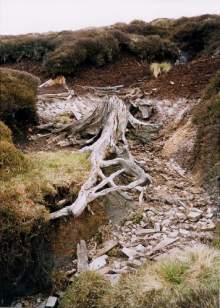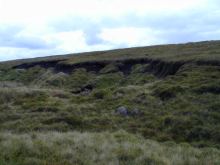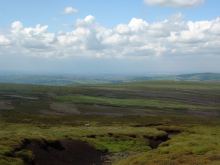What is peat?
- Peat, in the simplest terms, is an accumulation of partly decomposed plant material.
- Around 8% of the U.K. land area is covered by blanket peat - and this constitutes about 10-15% of the total world resource of this land cover type.
How does it form?

- Peat forms where the ground is waterlogged.
- These waterlogged soils are anaerobic (without oxygen).
- This slows down microbial activity within the soil, slowing down the breakdown of plant litter.
- As a result, peat formation is favoured in areas of high rainfall and low temperatures (which reduce evapotranspiration, stimulating further waterlogging).
- Sphagnum (bog moss) is the most important peat forming plant. It grows upward over partially decomposed remains of older Sphagnum.
Types of Peat Bog
1. Topogenous - Where the water source is drainage into the system.
2. Ombrogenous - Where the water source is rainfall only.
- This type is common across upland Britain as upland blanket bog.
- This is the bog type found at the Dark Peak.
When was it formed?
- Peat accumulation in the Peak District began between 8000 - 5500 yrs BP (before present).
- Its formation in the Dark Peak is linked to a reduction in forest cover brought about by climate change and human initiated forest clearance and burning, cultivation and grazing. This reduces evapotranspiration and increases waterlogging.
- The photo shows the stump of an 8,000 year pine tree below the peat and on top of the mineral soil. It is in situ - i.e. it is in the position in which it grew.
- This indicates that the blanket peat formed after the tree died.
What are the characteristics of blanket peat in the Dark Peak?

- Peat is over the top of mineral soils in a thick 'blanket' covering.
- Has high water tables.
- This causes the soil to be nutrient poor.
- It's therefore acidic. Typically between pH 3.5 & 6.0 - Excess acidity is toxic to some plants.
- Has two layers, the acrotelm & the catotelm.
Uses of Peat

- It is high in carbon, and can be used as a fuel - although peat is no longer burnt in the Peak District, it is in other areas of the British Isles e.g. parts of the Republic of Ireland & Scotland.
- The main commercial use for peat is in the production of garden composts, where it adds bulk and organic matter, helping the soil to retain moisture but not adding significant nutrients. In fact, its behaviour in the garden mimics that of the bog, which also retains lots of moisture but has a very low nutrient status - characteristics which are responsible for the distinctive plants which grow there (see vegetation pages).
- Can be used to find out information about the past. Find out more about peat's hidden history... .